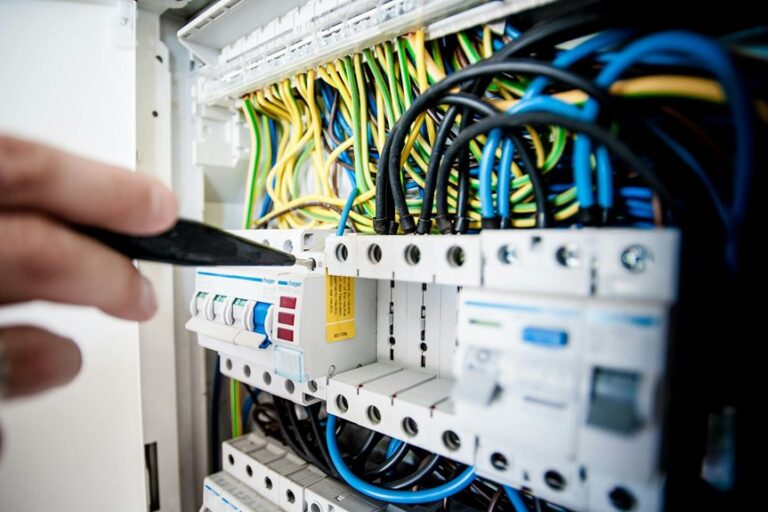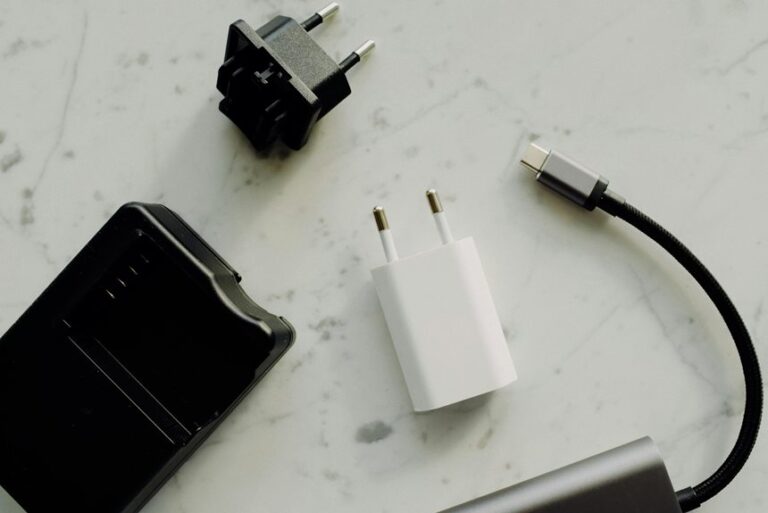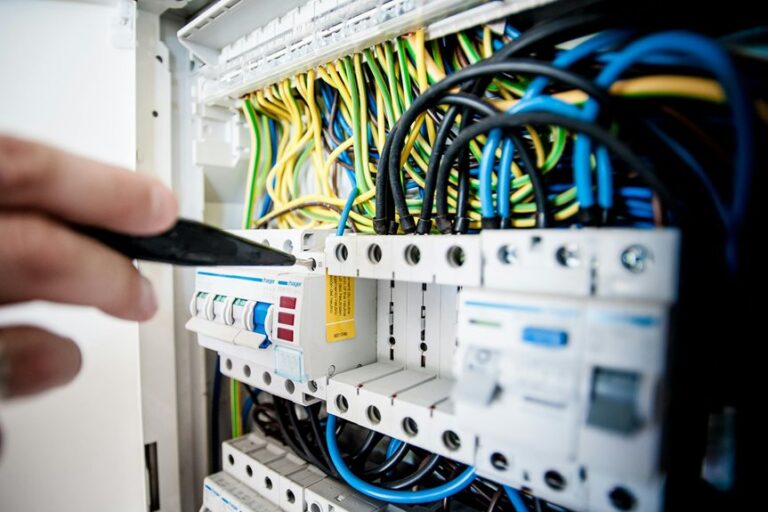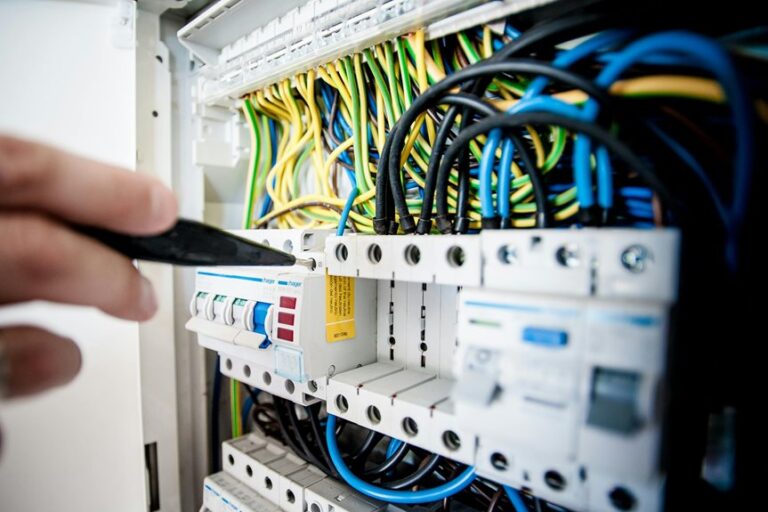You don't need to be a tech expert to install a smart home system effectively. Start by evaluating your space for ideal device placement, ensuring each unit aligns with your central hub and is near a power source. Adhere to electrical safety standards, using the proper mounting equipment to minimize risks. Once you've set everything up, you'll want to establish a secure network to protect your devices. Understanding the nuances of device configuration can greatly impact functionality, and that's just the beginning of what you need to know for a seamless experience.
Understanding Smart Home Systems
Understanding smart home systems involves recognizing the components and technologies that make them function seamlessly. You'll typically encounter devices like smart speakers, sensors, cameras, and smart hubs. Each plays a pivotal role in creating a cohesive environment.
Verify your Wi-Fi network is robust, as it forms the backbone of your smart home. A mesh network may be beneficial for covering larger spaces.
Next, focus on the integration of these devices. Protocols such as Zigbee, Z-Wave, and Wi-Fi are essential for communication. Choose a smart hub that supports multiple protocols to enhance compatibility.
When installing, adhere to safety guidelines: avoid overloading circuits, verify devices are securely mounted, and follow manufacturer instructions.
Pay attention to power sources; consider using surge protectors to prevent damage from voltage spikes. Additionally, configure your devices with strong, unique passwords to safeguard against unauthorized access.
Regularly update firmware to patch vulnerabilities. Remember, creating a smart home is about improving convenience while maintaining security.
Assessing Your Needs
Before diving into the installation process, it is vital to evaluate your specific needs for a smart home system. Understanding your requirements will help you create a tailored environment that enhances convenience, security, and energy efficiency. Start by examining the areas you want to automate and the functionalities that matter most to you.
Consider the following factors:
| Need Category | Examples |
|---|---|
| Security | Cameras, smart locks |
| Energy Management | Smart thermostats, lights |
| Convenience | Smart speakers, hubs |
| Health and Wellness | Smart air quality sensors |
Make a list of the features that are most important. Think about your daily routines, who lives in your home, and any specific challenges you face. For instance, if you travel frequently, prioritizing security features may be significant.
Also, verify your current home infrastructure can support the devices you're considering. Check your Wi-Fi coverage and electrical outlets, as these are vital for device performance. By evaluating your needs carefully, you'll pave the way for a successful smart home installation that aligns with your lifestyle.
Choosing the Right Devices
When choosing the right devices for your smart home system, guarantee compatibility with existing technology to avoid connectivity issues.
Assess your budget carefully; balance essential features with cost to maximize functionality without overspending.
Prioritize safety by selecting devices from reputable brands that comply with industry standards.
Device Compatibility Considerations
Choosing the right devices for your smart home system is essential, as compatibility issues can lead to frustrating malfunctions or limited functionality. Start by checking the communication protocols supported by your hub—common ones include Zigbee, Z-Wave, and Wi-Fi. Verify the devices you select are compatible with these protocols to facilitate seamless integration.
Next, consider the ecosystem of your smart home. If you're using a specific platform, like Google Home or Amazon Alexa, confirm that the devices you choose are compatible with that system. This can enhance voice control capabilities and streamline your user experience.
Pay attention to firmware updates and manufacturer support. Devices that receive regular updates are more likely to maintain compatibility over time. Additionally, look for products with good reviews regarding reliability and ease of integration.
Lastly, always prioritize safety. Confirm that devices meet safety standards, such as UL certification, to prevent electrical hazards.
Budget and Features Balance
Striking the right balance between budget and features is essential for building an effective smart home system. First, assess your needs. Do you prioritize security, energy efficiency, or convenience? This assessment will guide your device selection.
Next, set a budget that allows for essential devices without overspending. Consider allocating funds to a reliable smart hub, as it acts as the backbone of your system, guaranteeing device compatibility and control.
Once your budget's defined, research devices that fit your criteria. Compare specifications, focusing on compatibility with existing devices, user interfaces, and integration capabilities. Avoid opting for the cheapest devices; they may lack essential features or security updates, risking your system's integrity.
When selecting smart devices, prioritize those that offer robust security protocols, such as end-to-end encryption, to protect your data. Also, factor in ongoing costs, like subscriptions for cloud services or additional features.
Lastly, consider scalability. Choose devices that can easily integrate into your system, guaranteeing you can expand without replacing existing hardware.
Balancing your budget with the right features guarantees a smart home system that meets your needs while safeguarding your investment.
Planning Your Installation
Planning your installation is vital to guarantee a seamless integration of your smart home system. Start by evaluating your space and determining the specific areas where you'll place devices. This will help you identify the layout and secure effective communication between your devices.
Next, consider the following key factors:
- Device Compatibility: Verify all devices you choose are compatible with your central hub.
- Power Sources: Identify available power outlets for plug-in devices, and consider battery-operated options for flexibility.
- Signal Range: Assess the range of your Wi-Fi or hub's signal to avoid dead zones in your home.
- Safety Standards: Follow electrical safety guidelines and local codes to prevent hazards.
When mapping out your installation, prioritize areas that require automation the most, such as entry points or frequently used rooms.
It's vital to keep your devices within a reasonable distance from each other to maintain a strong connection.
Finally, take note of any existing wiring or infrastructure that might affect installation. Following these guidelines will guarantee your smart home system runs efficiently and safely.
Setting Up Your Network
To guarantee seamless connectivity for your smart home devices, start by choosing the right router that supports your bandwidth needs and smart technology.
Next, optimize Wi-Fi coverage by strategically placing the router and considering mesh systems if your home has dead zones.
Always prioritize network security by updating your router's firmware and using strong, unique passwords.
Choose the Right Router
Choosing the right router is essential for a smooth and efficient smart home system. Your router serves as the backbone of your network, guaranteeing seamless communication between devices.
When selecting a router, consider the following key factors:
- Speed: Look for dual-band or tri-band routers with high Mbps ratings to support multiple connections.
- Range: Confirm your router can cover your entire home, especially if you have smart devices in different rooms.
- Security Features: Opt for routers with WPA3 encryption, firewalls, and automatic firmware updates to protect your network from vulnerabilities.
- Compatibility: Confirm that the router supports all the smart home protocols you plan to use, such as Zigbee or Z-Wave.
Once you've chosen a router, place it in a central location, elevated for ideal signal distribution. Avoid placing it near metal objects or thick walls, as these can interfere with connectivity.
Regularly check for firmware updates to maintain security and performance. By prioritizing the right router, you'll guarantee a robust foundation for your smart home ecosystem, enabling reliable performance and enhancing your overall experience.
Optimize Wi-Fi Coverage
After securing the right router, optimizing your Wi-Fi coverage is the next step to confirm all your smart devices function seamlessly. Start by positioning your router in a central location within your home to minimize dead zones. Avoid placing it near metal objects or appliances that could interfere with the signal.
Wi-Fi Optimization Checklist
| Action | Description |
|---|---|
| Adjust Antennas | Position antennas vertically for better range. |
| Change Frequency Band | Use 5GHz for speed in close proximity; 2.4GHz for wider coverage. |
| Update Firmware | Verify your router firmware is current to enhance performance. |
Next, consider implementing a mesh Wi-Fi system if your home is large or has multiple floors. This setup provides extended coverage by distributing signals evenly.
Finally, regularly check for interference from neighboring networks by changing the channel on your router. Use apps to identify the best channel to optimize your network's efficiency. By following these steps, you'll create a robust network that supports your smart home ecosystem efficiently and safely.
Installing Smart Devices
Installing smart devices can seem intimidating, but with the right approach, it's a straightforward process. Start by verifying your devices are compatible with your smart home ecosystem. Read the manufacturer's guidelines for specific installation instructions, as they may vary between devices.
Here are some essential steps to follow:
- Power Off: Always turn off power at the circuit breaker before handling any electrical components. Safety first!
- Mounting: Use appropriate anchors and screws when mounting devices like smart cameras or lights to guarantee stability.
- Connect Wiring: Follow color-coded wiring standards for smart switches and plugs. Double-check connections for secure fitting.
- Test Functionality: Once installed, restore power and test the device to confirm it's working properly before securing everything back in place.
Configuring Your System
Configuring your smart home system is essential for peak performance and security. Begin by downloading the manufacturer's app for your central hub or smart devices. Verify your smartphone is connected to a reliable Wi-Fi network with a strong signal; this will facilitate seamless communication between devices.
Next, open the app and create an account if you haven't already. Follow the on-screen instructions to add each device individually—most devices will require you to scan a QR code or enter a setup code. When prompted, connect each device to your Wi-Fi network, making sure you use a secure password to prevent unauthorized access.
For best performance, configure device settings according to your preferences. Set up routines or automations to enhance functionality—like scheduling lights to turn on at sunset.
Don't forget to enable two-factor authentication for your account; this adds an extra layer of security.
Lastly, keep your firmware updated. Regularly check for updates within the app and install them promptly. This guarantees your system benefits from the latest features and security patches, protecting your smart home environment from vulnerabilities.
Testing and Troubleshooting
Testing your smart home system is essential to confirm everything operates correctly and securely. Start by conducting a thorough test of each device to confirm they communicate effectively with your central hub. This step helps identify any potential issues before they become significant problems.
Here are some key areas to check:
- Connectivity: Verify that all devices connect to your Wi-Fi and are within range of your router.
- Functionality: Test each device's primary functions, such as turning lights on/off, adjusting thermostats, and locking doors.
- Automations: Run your scheduled automations to confirm they trigger at the correct times and in the right sequence.
- Security: Check that your security features, like cameras and alarms, are active and sending notifications properly.
If you encounter issues, troubleshoot systematically. Restart the affected device and check for firmware updates. If problems persist, consult the manufacturer's support resources or forums for guidance.
Always prioritize safety; disconnect power sources if you're inspecting hardware. Regular testing not only secures your system but also enhances your smart home experience.
Maintaining Your Smart Home
Once you've confirmed your smart home system is functioning properly, ongoing maintenance is essential to keep everything running smoothly. Regular updates, inspections, and troubleshooting will help you avoid potential issues.
Smart Home Maintenance Schedule
| Task | Frequency | Notes |
|---|---|---|
| Software Updates | Monthly | Verify firmware is current. |
| Device Inspection | Quarterly | Check for any hardware malfunctions. |
| Battery Replacement | Annually | Replace batteries in sensors/remote devices. |
| Network Security Audit | Bi-Annually | Change passwords and check firewall settings. |
| Performance Review | Annually | Assess system for enhancements. |
To maintain peak functionality, schedule these tasks on a calendar. Always prioritize safety; if you're unsure about handling an update or inspection, consult a professional. Avoid overloading your network by limiting the number of connected devices. Regularly back up your configurations to prevent data loss. By following these guidelines, you can verify your smart home operates efficiently, enhancing both security and convenience in your daily life.
Conclusion
As you commence this journey to a smarter home, think of each device as a star in your personal galaxy. With careful planning and attention to safety, you'll create a constellation that works in harmony. Secure your network like a fortress, ensuring only trusted visitors can enter. Regular maintenance is your guiding light, keeping everything running smoothly. By testing and troubleshooting, you'll navigate any dark clouds. Embrace the brilliance of your smart home, and let it shine in everyday life.








